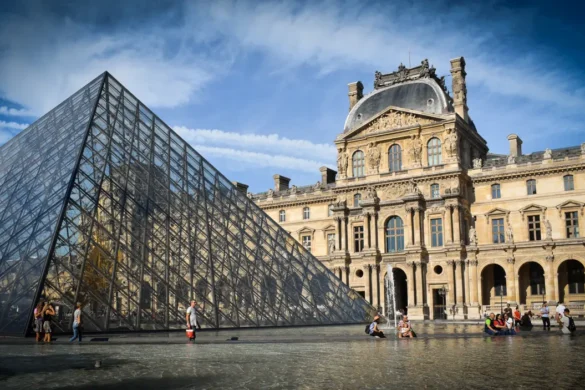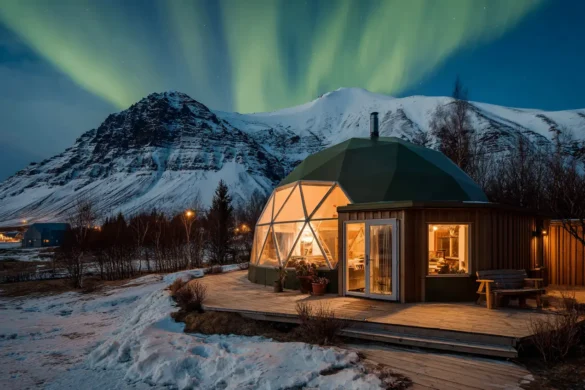I’ve spent the last eight years chasing stories and sunsets across Europe, visiting 39 countries along the way. Every year, I carve out at least two months here. Partly because my wife is Austrian, but mostly because I can’t stay away. And no matter where I go, I always end up gravitating toward the Old Towns.
They’re my favorite places to slow down. The worn cobblestones under my feet, the smell of fresh bread drifting from a bakery, the way the late afternoon light hits a row of pastel houses. It never gets old! In some towns, the streets twist like a maze; in others, everything opens up to a grand square that’s been the heart of the community for centuries.
This list is a collection of the Old Towns that have completely swept me off my feet. From alpine villages tucked beneath snow-capped peaks to sunny harbors lined with pastel homes, these are the places that keep me coming back year after year.
Most Beautiful Old Towns in Europe
If you’re planning a trip to Europe and want to soak up serious charm, this guide’s got you covered. Here’s a quick-hit list of the most beautiful old towns, each with its own vibe and story. Tap any name to skip to that part of the post.
- Most Fairytale-Like City: Bruges, Belgium
- Best Mediterranean Vibes: Marbella, Spain
- Most Iconic Historic Square: Prague, Czech Republic
- Hidden Gem in Transylvania: Sibiu, Romania
- Ultimate Living Museum: Rome, Italy
- Best For Elegant Architecture: Vienna, Austria
- Coolest Canal City: Amsterdam, Netherlands
- Most Resilient Comeback Story: Warsaw, Poland
- Most Unexpected Historic Escape: Ibiza, Spain
- Top Winter Wonderland Feel: Tallinn, Estonia
- Best Preserved Polish Beauty: Krakow, Poland
- Most Scenic Lakefront Town: Lucerne, Switzerland
- Best Hidden Seaside Gem: Nafplion, Greece
Here’s how I’d do it: spend a few days in Krakow or Bruges for that full-on old town immersion, sprinkle in spots like Sibiu and Nafplion to beat the crowds, and don’t miss Ibiza or Marbella if you want that sunny coastal energy. Full details, hidden corners, and planning tips are just ahead!

1. Bruges, Belgium
Bruges just hits different, you know? I’ve been back three times now, and honestly, it gets better every visit. The canals are ridiculously picturesque – like someone took every fairytale you’ve ever read and turned it into a real place. The Belfry Tower is absolutely worth the climb (366 steps, but who’s counting?), and they’re smart about limiting crowds now – you can book timed entry tickets online for €15 to skip the worst of the lines.
The Christmas Market here is actually insane. From late November through December, Grote Markt transforms into this magical winter wonderland that’ll make you believe in holiday spirit again. I went last December and couldn’t stop taking photos – every corner looked like a postcard. Canal boat tours run daily and cost about €15, and they’re way better than I expected. Sure, it’s touristy, but watching the medieval buildings drift by from water level? Totally worth it.
Pro tip: arrive early morning (like 8 AM early) if you want those Instagram shots without a thousand other people in them. The town gets absolutely slammed by mid-morning, especially on weekends. And don’t sleep on the chocolate shops – De Garre has this killer beer selection if you need a break from all the walking. Train from Brussels takes just over an hour and runs every 30 minutes, making it perfect for a day trip.
- Read next: UNESCO World Heritage Sites
- You may also like: Unmissable Activities in Bruges, Belgium

2. Marbella, Spain
Marbella‘s Casco Antiguo is this incredible mix of old-world charm and modern Spanish energy that just works. I spent three days getting completely lost in those narrow whitewashed streets, and honestly, that’s exactly how you should explore it. Plaza de los Naranjos is the heart of everything – grab a table at one of the cafes and just watch the world go by. The orange trees smell amazing, especially in spring.
The best time to hit Marbella is actually October through March if you want to avoid the insane summer crowds and heat. I went in February and had the place almost to myself, plus restaurant prices were way more reasonable. The weather’s still gorgeous – highs in the 60s and plenty of sunshine. Summer’s great if you’re here for the beaches, but the old town becomes a zoo, and everything costs twice as much.
Church of Our Lady of the Incarnation is worth a quick stop, and the Moorish Castle ruins give you some nice views over the town. But really, the magic here is just wandering around. I found this tiny tapas place called La Taberna del Pintxo on one of the narrowest streets that served the best pintxos I’ve had outside the Basque Country. The Alameda Park is perfect for a break when your feet start hurting from all the cobblestones. Everything’s walkable, so don’t bother with a car in the old town.
- Read next: Magical Spots in Costa del Sol
- You may also like: Breathtaking Places in Andalusia
- For more reading: Must-See Europe Attractions & Activities

3. Prague, Czech Republic
Prague‘s Old Town Square is absolutely mental during the hourly show at the Astronomical Clock – I’m talking hundreds of people pointing phones at this medieval timepiece. But here’s the thing: it’s actually pretty cool once you understand what you’re looking at. The apostles do their little parade every hour from 8 AM to 11 PM, and yeah, it’s only 45 seconds, but the whole spectacle is worth seeing at least once.
✈️ My #1 Hack for Cheap 2026 Flights:
It’s January, so flight prices are climbing fast—but you don't have to pay them. I’m currently seeing roundtrips to Europe for under $300 (deals you won’t find on Google Flights).
Step 1: Join Going.com's Free Plan here. It takes 10 seconds and requires no credit card.
Step 2: If you're doing a big trip this year, grab the 14-day free trial of Premium. You can even use my code JON25 for 25% off.
Seriously, this is the single best money-saving tool I’ve used in 8+ years.
👉 Send me cheap 2026 flightsIf you want the full experience, pay the 250 CZK (about €10) to go up the Old Town Hall Tower. The views are incredible, and you get to see the clock mechanism from behind, which honestly impressed me more than the hourly show. They’ve got elevators now for an extra €4, which is a godsend because those medieval stairs are no joke. I visited in March and the weather was perfect – cool enough to walk around comfortably but not freezing.
St. Mary’s Basilica and the Charles Bridge are obviously must-sees, but don’t miss just wandering the smaller streets off the main square. I found this incredible beer hall called U Fleků that’s been brewing since 1499 and makes their own dark lager. The whole Staré Město area is compact enough to walk everywhere, and the Metro Line A gets you here easily from anywhere in the city. Just bring cash – lots of places still don’t take cards, especially the smaller shops and street vendors.

4. Sibiu, Romania
Sibiu completely caught me off guard. I originally planned just a day trip, but ended up staying three nights because this place has serious charm. Piața Mare (Big Square) is where everything happens – the Brukenthal Museum is worth the entry fee just for the building itself, and the Council Tower gives you these amazing views over the whole old town for just 2 lei (like 50 cents). I climbed it twice because the sunset views were insane.
Those famous “eyes of Sibiu” – the windows built into the rooftops – are everywhere once you start looking. It’s like the whole town is watching you, but in a cool way, not creepy. The Bridge of Lies has this fun legend about collapsing if you tell a lie while standing on it (spoiler: it doesn’t actually collapse). Huet Square and Little Square are way less crowded than the main square but just as beautiful.
I went in October and the weather was perfect – crisp but sunny, with some light snow that made everything look like a Christmas card. Summer’s the peak season with festivals happening constantly, but I actually loved the quieter vibe in fall. The Marginimea Sibiului villages around Sibiu are incredible if you’ve got a car – traditional rural life that feels like stepping back 200 years. Food here is ridiculously cheap and hearty – I had massive meals for under €10. The ASTRA Museum is a bit outside town but worth the bus ride if you’re into traditional architecture and village life.
- Read next: Things to Do in Transylvania

5. Rome, Italy
Rome’s Centro Storico is basically a giant outdoor museum where people actually live and work, which is kind of mind-blowing when you think about it. The Colosseum opens at 8:30 AM and trust me, you want to be there when the doors open. Standard tickets are €18 but sell out constantly, so book online 30 days in advance. The arena floor access is an extra €8 but totally worth it – standing where gladiators fought is pretty surreal.
Trevi Fountain is a madhouse basically 24/7, but there’s this trick I learned: go to the United Colors of Benetton store that faces the fountain, head to the second floor, and you can get perfect views without the crowds. The fountain’s free (obviously), but bring a coin for the tradition – they collect about €3,000 daily and it goes to charity. Pantheon entry is now €5 (they started charging in 2023), but seeing that dome in person is incredible.
I actually love Rome in winter – fewer tourists, mild weather, and restaurant prices drop significantly. The Spanish Steps are perfect for people-watching, and Piazza Navona has this energy that’s impossible to describe. Walking everywhere is totally doable since most major sights are within a 20-minute walk of each other. The Roma Pass (€38 for 48 hours) includes public transport and fast-track entry to two major sites, plus discounts on everything else. Street food here is amazing – grab supplì (fried rice balls) from any corner shop for a quick €2 snack.
- Read next: Prettiest Spots in Rome
- You may also like: Magical Things to Do in Rome at Night

6. Vienna, Austria
Vienna‘s Innere Stadt has this elegant, sophisticated vibe that makes you feel fancy just walking around. Kärntner Straße is the main shopping drag, but honestly, window shopping here is entertainment enough. The State Opera House tours are €12 and give you access to areas you’d never see otherwise – the backstage stuff is fascinating even if you’re not into opera.
St. Stephen’s Cathedral is free to enter, but climbing the South Tower costs €6 and gives you incredible views over the city. I went up there twice – once during the day and once for sunset, and sunset definitely wins. The Hofburg Palace is massive and you could spend days there, but the Imperial Apartments tour (€18) gives you a good overview without killing your whole day.
Viennese coffee culture is the real deal here. I probably spent more time in cafes than museums, and honestly, that’s exactly how Vienna should be experienced. Central Café and Landtmann are touristy but legendary for a reason. Try sachertorte at least once – it’s everywhere, and every place claims theirs is the best. The U-Bahn system is incredibly efficient and a day pass is only €8. I visited in April and the weather was perfect – warm enough to sit outside but not hot, and the city parks were in full bloom.
- Read next: Unique Places to Eat in Vienna
- You may also like: Best Attractions & Experiences in Vienna

7. Amsterdam, Netherlands
Amsterdam‘s canals are obviously gorgeous, but what really gets me is how the whole city just flows around them. De Wallen (the red light district) gets all the attention, but Jordaan and Nieuwmarkt neighborhoods have way more character. I rented a bike like every tourist does, and yeah, it’s actually the best way to get around – just watch out for trams and other cyclists who know what they’re doing.
Oude Kerk is Amsterdam‘s oldest building and worth a look, especially if there’s an art installation going on. The Royal Palace on Dam Square does tours for €12.50, but honestly, the outside is more impressive than the inside. Canal boat tours are everywhere and cost about €18 – they’re touristy but you see the city from a completely different perspective.
Coffee shops are… well, you know what they are. But the actual coffee culture here is incredible. I found this tiny place called White Label Coffee that roasts their own beans and makes better espresso than half the places in Italy. The Amsterdam Museum gives you good context for how this crazy city developed around all these canals. Getting around is super easy – bikes, trams, metros, everything’s connected. I went in September and the weather was ideal, but be prepared for rain any time of year. Pack layers and a good rain jacket.
- Read next: Unique Dining in Amsterdam

8. Warsaw, Poland
Warsaw‘s Stare Miasto has this incredible comeback story that makes it even more impressive when you see it in person. The whole old town was basically flattened in WWII, then rebuilt brick by brick from old paintings and photographs. Walking around Old Town Market Square now, you’d never guess it’s only been standing since the 1950s.
St. John’s Cathedral and The Barbican are the highlights, but honestly, just wandering the restored streets is pretty amazing. The Royal Castle does tours for about 25 PLN (€6), and they do a good job explaining the reconstruction process. Castle Square gets packed during summer, but even with crowds, the energy is great – street performers, outdoor cafes, people just hanging out.
I visited in May and the weather was perfect – warm days, cool evenings, and everything was in bloom. The Vistula River waterfront is great for a break from all the history, and there are tons of bars and restaurants along the water. Food here is ridiculously cheap and hearty – massive plates of pierogi for like €5. The old town connects perfectly to the rest of Warsaw via metro and trams, so it’s easy to pop over to other neighborhoods. The Museum of Warsaw gives you great context for understanding how they pulled off this massive reconstruction project.

9. Ibiza, Spain
Ibiza‘s Dalt Vila is probably the most underrated old town on this entire list. Everyone thinks Ibiza = clubs and beaches, but this UNESCO World Heritage site is legitimately incredible. The 16th-century walls are perfectly preserved, and walking up through the narrow streets feels like you’re in Game of Thrones or something.
Ibiza Castle at the top gives you these insane views over the Mediterranean, and the Roman ruins scattered around are way older than anything else on the island. La Marina down by the port has great restaurants and bars – I found this place called Comidas San Juan that does amazing paella away from all the tourist traps.
The best part about Dalt Vila is how different it feels from the rest of Ibiza. It’s quiet, historic, and actually Spanish rather than international party central. I climbed up there during sunset and had the whole place almost to myself – just me, ancient walls, and incredible views. Entry to the main areas is free, though some specific sites charge a few euros. Sa Penya neighborhood at the base has this authentic local vibe with tiny bars and shops that have been family-run for generations. October through April is perfect weather without the summer madness, plus you can actually get hotel rooms at reasonable prices.

10. Tallinn, Estonia
Tallinn‘s Vanalinn feels like someone built a medieval theme park, except it’s all completely real and people actually live there. The Christmas Market here is seriously world-class – they run it from late November through December, and it was named one of the best in Europe by multiple travel magazines. The Christmas tree in Town Hall Square has been a tradition since 1441, making it possibly the oldest Christmas tree tradition in Europe.
Danish King’s Garden and the medieval city walls are perfect for getting those fairytale photos, and you can actually walk on top of the ancient fortifications. The Gothic spires and colorful medieval houses look amazing any time of year, but there’s something magical about winter here when everything’s covered in snow and the market stalls are steaming with glögi (mulled wine).
I went in December and yeah, it was cold, but the atmosphere was incredible. Street performers, traditional Estonian food like verivorst (blood sausage – better than it sounds), and handmade crafts everywhere. Summer’s great too – the white nights mean daylight until like 11 PM, and the streets come alive with outdoor cafes and festivals. Everything’s walkable in the old town, and Tallinn itself is small enough to see in a day or two. The ferry from Helsinki takes just 2 hours if you want to add it to a Finland trip. The €3 mulled wine at the Christmas markets might be the best value drink in Europe.
- Read next: Dreamy Places to Live in Europe
- You may also like: Magical Winter Destinations

11. Krakow, Poland
Krakow‘s Stare Miasto is hands down one of the best-preserved medieval cities I’ve ever seen. Main Market Square is absolutely massive – it’s apparently one of the largest medieval squares in Europe, and you believe it when you’re standing there. St. Mary’s Basilica does this trumpet call every hour that’s been happening for centuries, which is oddly moving when you hear it echo across the square.
Wawel Castle up on the hill is impressive, but honestly, I loved just sitting in the square with a beer watching the horse-drawn carriages and street performers. The flower market is beautiful, especially in spring and summer, and the Cloth Hall has decent souvenirs if you’re into that. Unlike Warsaw, this is all original medieval architecture that survived the war intact.
The food scene here is incredible and ridiculously cheap. I had amazing meals for under €8, and the beer is like €2 a pint. Kazimierz (the Jewish quarter) is a short walk away and has this amazing mix of history and modern bars and restaurants. I visited in April and the weather was perfect – warm enough for outdoor seating but not hot. The Rynek Underground Museum under the main square shows you archaeological remains from the original market, which is pretty cool if you’re into that stuff. Everything’s walkable, but the trams are efficient and cheap if your feet get tired.
- Read next: Cheapest Countries to Visit in Europe

12. Lucerne, Switzerland
Lucerne‘s Altstadt is like someone took a postcard and made it three-dimensional. The Lake Lucerne backdrop with snow-capped mountains is almost unfairly beautiful. Chapel Bridge (Kapellbrücke) is the iconic shot everyone gets, and yeah, it’s touristy, but walking across this 14th-century covered wooden bridge is pretty special, especially when you realize they rebuilt it after a fire in 1993.
The Musegg Wall and its towers give you incredible views over the lake and city – you can climb several of the towers for free, which is amazing considering this is Switzerland where everything costs a fortune. I went up the Zyt Tower and spent way too long just staring at the scenery. Mount Pilatus is right there if you want to go higher, but honestly, the views from town are incredible enough.
I visited in July and the weather was perfect – warm but not hot, and you could actually swim in the lake if you wanted to cool off. The old town is small enough to walk everywhere in 30 minutes, but you’ll want to spend way longer just soaking it all in. Switzerland is expensive, obviously, but Lucerne felt more reasonable than Zurich or Geneva. A simple lunch was still like €25, but the setting makes it worth it. The train connections are incredible – you can be in Zurich in an hour or up in the Alps in 30 minutes.
- Read next: Underrated Places in Switzerland
- You may also like: Fun Things to Do in Lucerne
- For more reading: Beautiful Places to Explore in Switzerland

13. Nafplion, Greece
Nafplion is Greece’s best-kept secret, and I’m almost hesitant to write about it because it’s so perfectly unspoiled. This little Peloponnese harbor town has everything – Venetian architecture, crystal-clear water, incredible food, and none of the crowds you get in the islands. Palamidi Fortress requires a bit of a hike (999 steps), but the views over the harbor and old town are absolutely worth the sweat.

The old town is this maze of narrow streets filled with tavernas and little shops, all with that beautiful Venetian influence. I spent hours just wandering around getting lost and discovering tiny squares and hidden cafes. The harbor front is perfect for sunset drinks – I found this place called Alaloum that does amazing seafood and has tables right on the water.
Bourtzi fortress on the little island in the harbor makes for great photos, and you can take a water taxi out there for a few euros. The beaches around Nafplion are way better than anything you’ll find near Athens, and the whole area feels authentically Greek rather than tourist-focused. I went in October and the weather was still perfect for swimming, plus the summer crowds were gone. Restaurant prices here are incredibly reasonable – amazing fresh fish dinners for under €20. It’s about 2 hours from Athens by bus, making it perfect for a few days away from the city chaos.
- Read next: Prettiest Places in the Mediterranean
- You may also like: Hidden Gems in Europe

Global Viewpoint is a personal blog. All content is for informational and entertainment purposes only and does not constitute professional financial, medical, or legal advice.






